Here we have an interesting case of involving a young child with high myopia and astigmatism. PC is looking for recommendations on how to manage this highly myopic toddler, with the discussion ranging from co-mangement, to the best optical correction, to the lifelong eye health strategies required of this case.

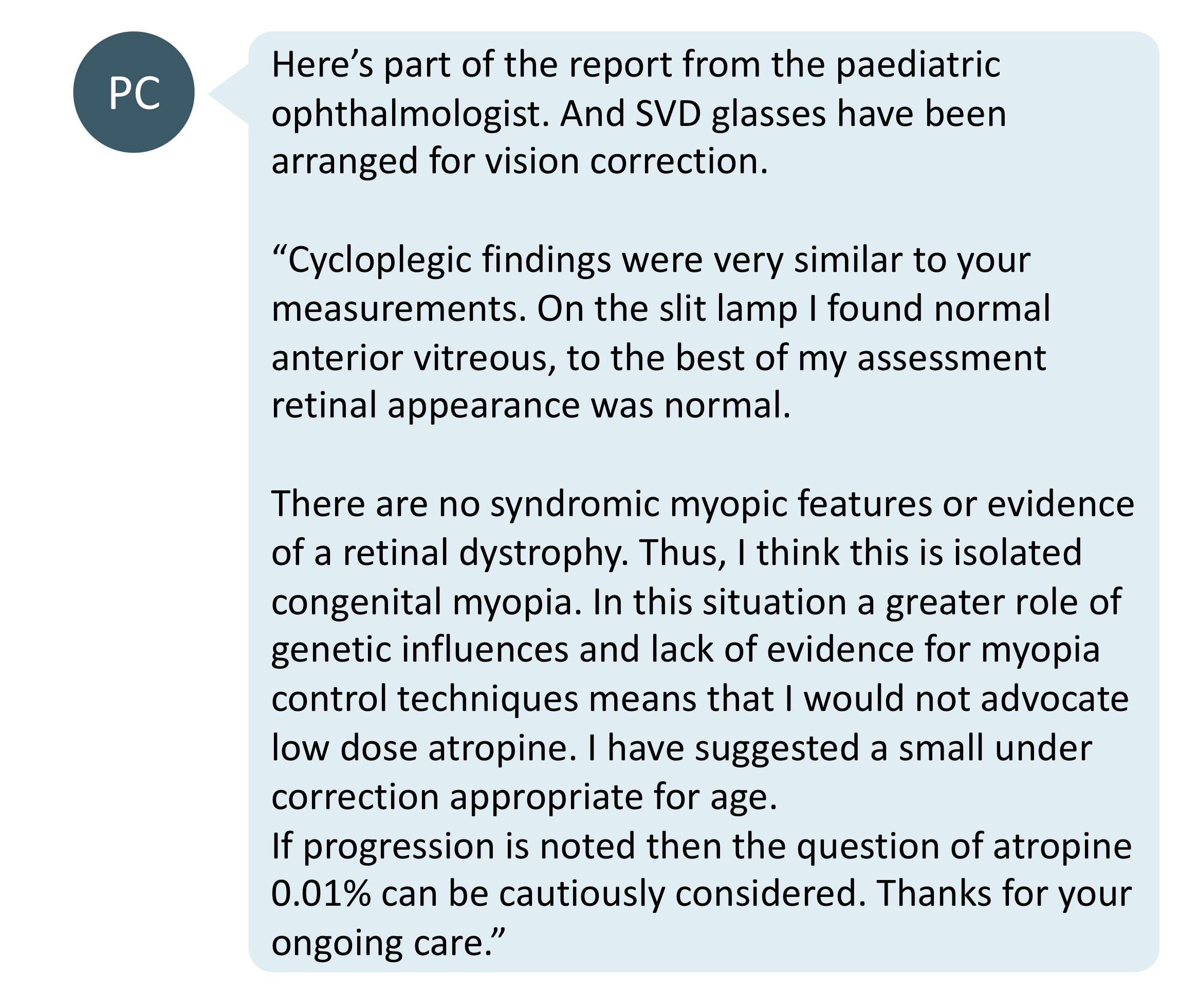
Step 1: Pediatric Ophthalmologist Referral
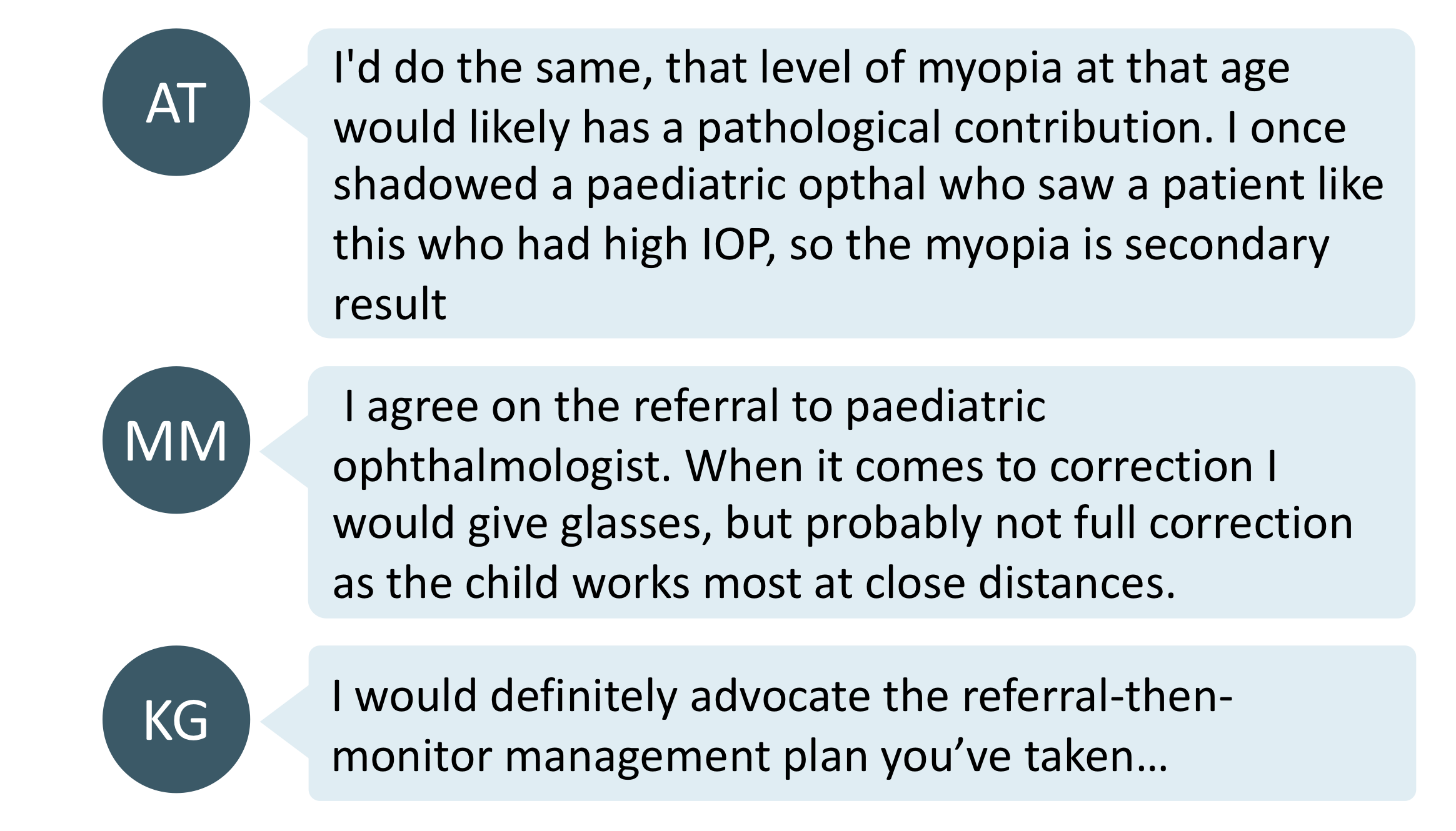
A 2-year-old child with such a high degree of myopia is best to be initially referred to a pediatric ophthalmologist in order to rule out any associated ocular or systemic disease. From the ophthalmologist report, this child has congenital myopia without any co-morbidities. Hence the management plan falls back to the optometrist to maximize pediatric visual development, and co-management over time can of course take place as required.
Step 2: Vision Correction
Before prescribing visual aid, the following questions should be considered1:
- Is the refractive error within the normal range for the child's age?
- Will this particular child's refractive error emmetropise?
- Will this level of refractive error disrupt normal visual development or functional vision?
- Will prescribing spectacles improve visual function or functional vision?
According to Mayer et al, a 2-year-old is estimated to have spherical equivalent of +1.2D.2 It is also possible for a myopic infant to emmetropise between 9 months old to 4 years old.3,4 In congenital myopia, the blurry images on the foveal and macular regions of the retina can disrupt normal visual development. This can become an amblyogenic factor. With partial spectacle correction, emmetropisation would not be affected whilst avoiding potential amblyopia. This will reduce the possibility of vision problems later on.3 Therefore one can decide to under-correct by 0.50D – 1.00D until the child reaches schooling age.1
Glasses vs. contact lenses
In this case, a single vision spectacle lens with slight under correction was recommended by the ophthalmologist. As emmetropisation has not fully occurred, giving the child the best visual acuity remains the priority, with myopia control strategies a secondary concern at this time. Below are some opinions from the Facebook community on managing this myopic toddler:
Glasses
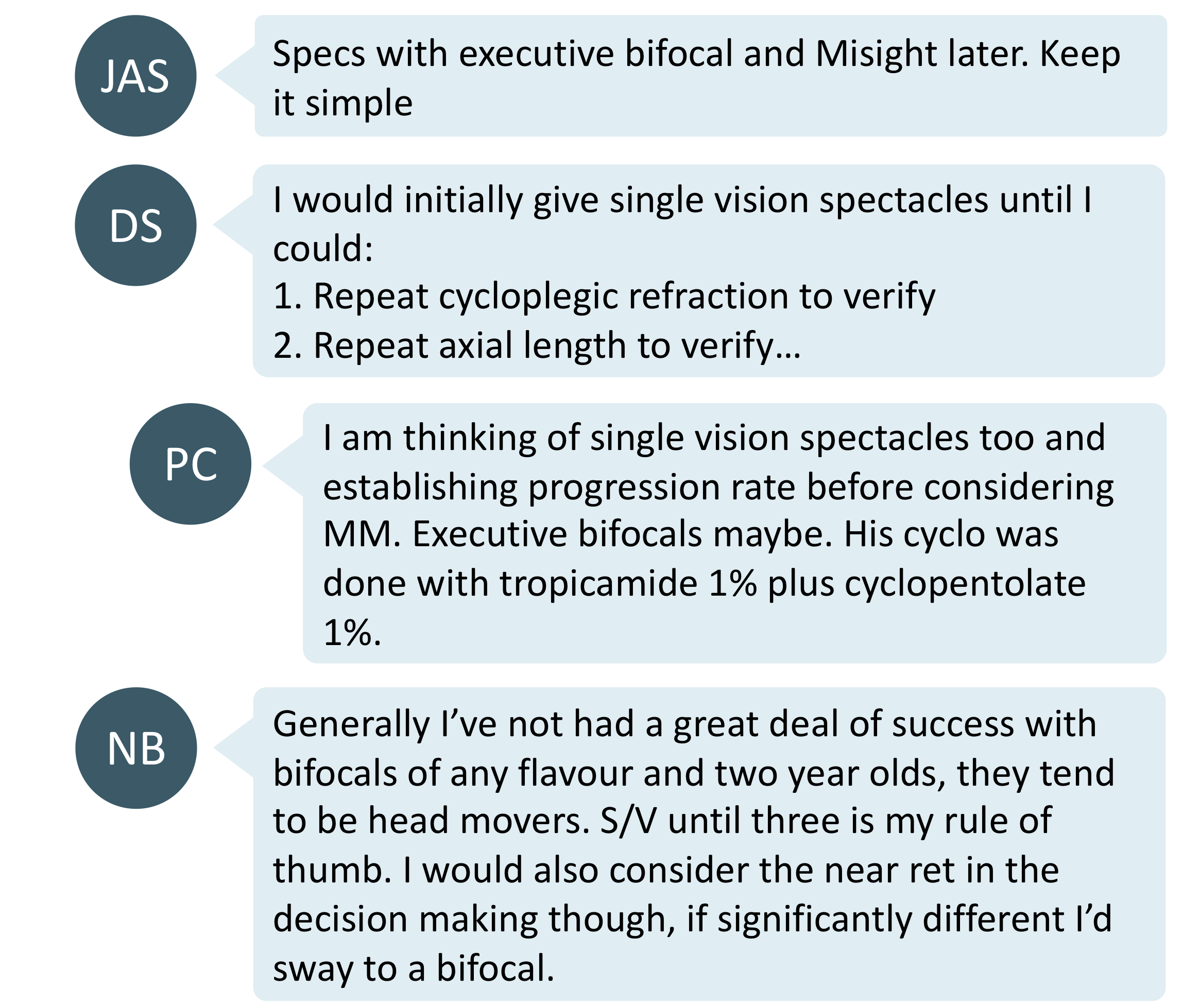
The commenters suggested single vision or bifocal spectacle lenses. Single vision lenses would help achieve visual correction. Bifocal and myopia controlling lenses could both be considered as both can correct vision and have a myopia control effect. However, there was comment about how well a bifocal would be used in a 2-year-old, and while there is no available data, the modified optics of some myopia controlling spectacle lenses could potentially interfere with visual development in a child so young, where visual clarity has been prioritized in his initial management.
Contact lenses
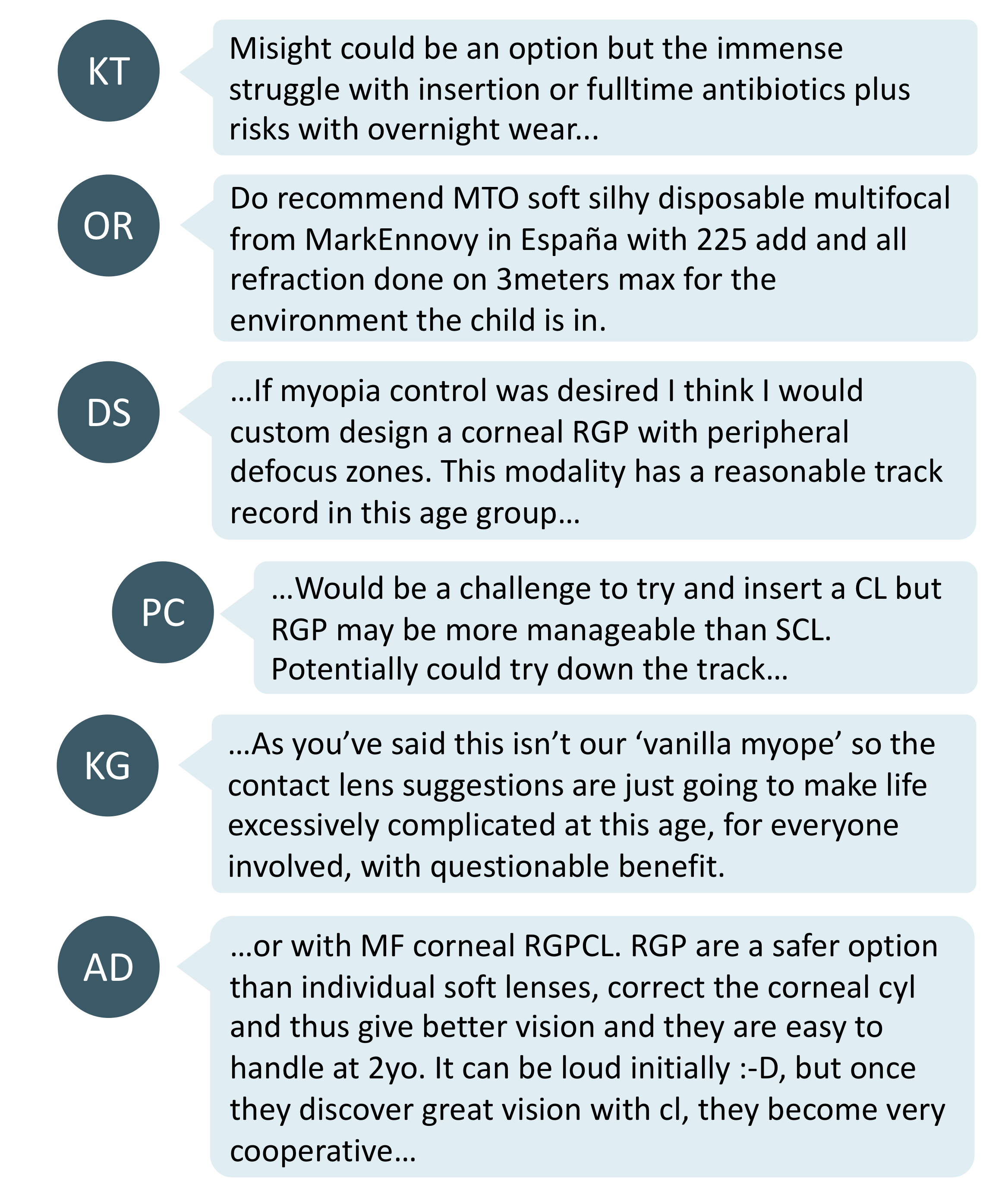
Applying contact lens on a 2-year-old child is a challenge for both the practitioner and the parent. As a result, we require full parental commitment to help with applying, removing and cleaning contact lens. The risks of overnight wear - likely in this age group to simplify parental handling - also need to be considered and discussed. As this option may end up requiring much time, money and energy for little gain, it may not be the ideal choice.
If parents choose the contact lens route, one can expect RGP lenses to be more manageable and healthy than soft contact lenses. Some suggested soft MFCLs or RGP MFCLs for the myopia control effect. It is important to consider the pros and cons of using MFCLs. This is because these forms of correction at such a young age could affect the visual development of the child, where achieving good visual clarity is the main goal of management.
Atropine
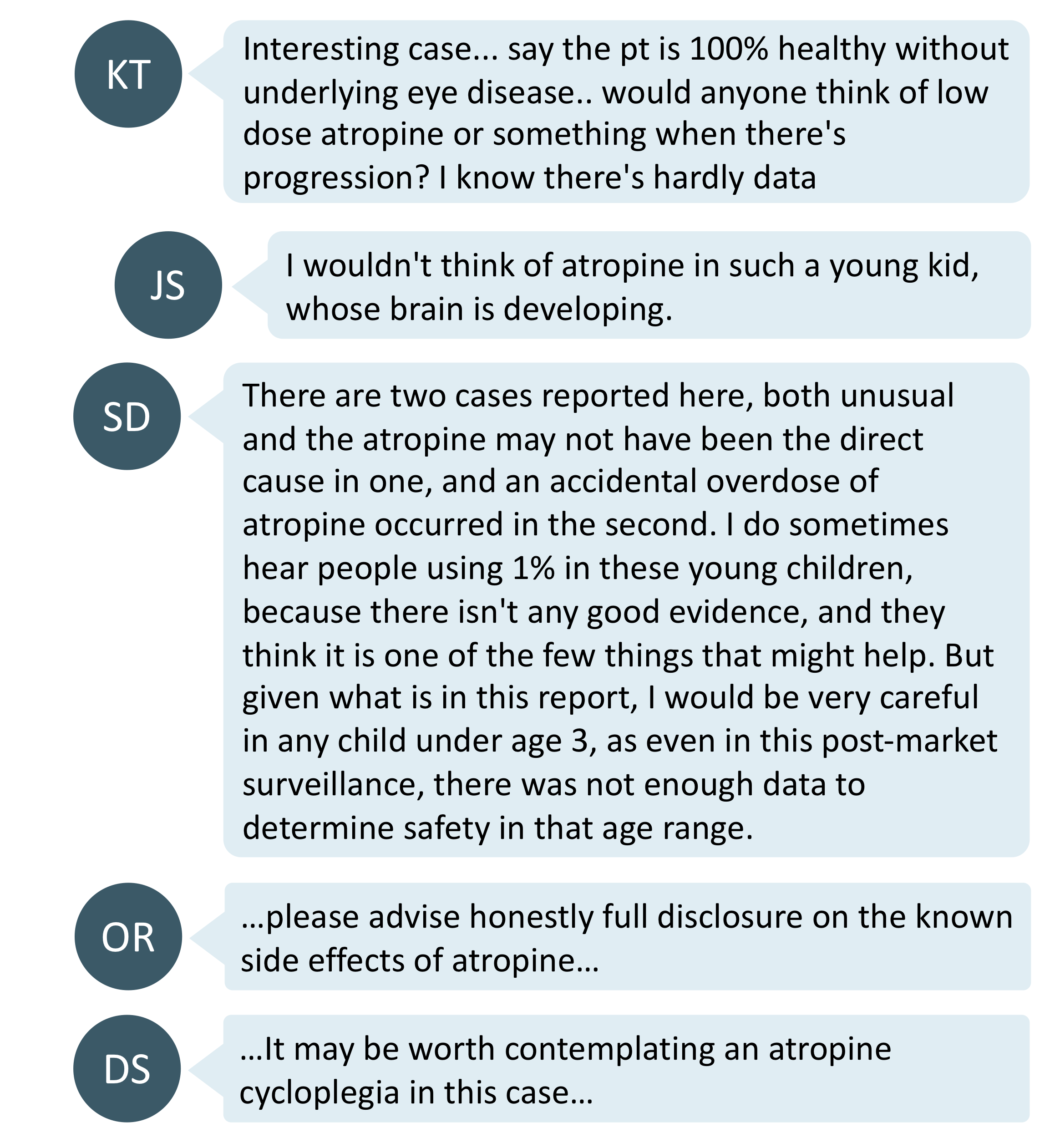
The potential systemic side effects of atropine are mainly cardiovascular in nature. This includes palpitations, tachycardia and atrial arrhythmia. Siurana et al found that while 0.01% atropine was safe for their subjects (mean age 10.2 years), 3 months of use did lead to a significant decrease in heart rate.5 Because of these risks, extreme caution must be taken when prescribing atropine to children below 3 years old. Read more about Systemic Side Effects of Atropine Eye Drops here.
Step 3: Parent Education
When a young child has significant levels of myopia, this will be the beginning of a lifelong myopia management journey for the parents and child.
In addition to discussing myopia correction and control, it is important to educate the parents on the importance of visual environment. They must also be aware of the increased risk of rapid myopia progression with early onset, and the higher risk of ocular disease across their child's lifetime. This will help them understand the importance of implementing myopia control strategies later down the track, once this initial correction and early visual development phase has been managed.
Step 4: Future Plan for Myopia Management
The options mentioned by the Facebook community are all potential myopia management strategies. The choice between glasses or contact lenses - now and in future - would ultimately depend on the child’s ocular conditions, along with his and his parents' capacity.
If there is rapid myopia progression, one can also consider combination treatment with atropine at a later stage. Data is early but promising on combinations of atropine with orthokeratology and multifocal soft contact lenses.
Regardless of the myopia control strategy chosen, a crucial part of myopia management for this child will be frequent follow up to monitor changes in refractive error and ocular health.
Take home messages:
- When managing a myopic toddler, early optical correction is vital to prevent amblyopia, prioritising visual clarity and full time wear of the correction. Most colleagues in this discussion advocated single vision spectacles as the first choice for this child.
- In pediatric high myopia, initial co-management with ophthalmology is critical, to rule out any potential systemic co-morbidities. Ongoing co-management of these cases will be needed if there are co-morbidities, retinal health concerns and/or if your scope of practice requires this additional support.
- When children are this myopic at this young an age, parents need to be aware of the lifelong commitment to managing the myopia that will inevitably progress.
Further reading on prescribing for young children

About Kimberley
Kimberley Ngu is a clinical optometrist from Perth, Australia, with experience in patient education programs, having practiced in both Australia and Singapore.

About Connie
Connie Gan is a clinical optometrist from Kedah, Malaysia, who provides comprehensive vision care for children and runs the myopia management service in her clinical practice.
This content is brought to you thanks to an unrestricted educational grant from
![]()
References
- Leat SJ. To prescribe or not to prescribe? Guidelines for spectacle prescribing in infants and children. Clinical and experimental Optometry. 2011;94(6):514-27. (link)
- Mayer DL, Hansen RM, Moore BD, Kim S, Fulton AB. Cycloplegic refractions in healthy children aged 1 through 48 months. Archives of Ophthalmology. 2001 Nov 1;119(11):1625-8. (link)
- Atkinson J, Braddick O, Bobier B, Anker S, Ehrlich D, King J, Watson P, Moore A. Two infant vision screening programmes: prediction and prevention of strabismus and amblyopia from photo-and videorefractive screening. Eye. 1996 Mar;10(2):189-98. (link)
- Ehrlich DL, Atkinson J, Braddick O, Bobier W, Durden K. Reduction of infant myopia: a longitudinal cycloplegic study. Vision research. 1995;35(9):1313-24. (link)
- Siurana JM, Akel G, Cavero L, Mones A, Anabalon E, Ventura PS. GP122 Is treatment with atropine 0.01% eyedrops safe to prevent the progression of childhood myopia?. Archives of Disease in Childhood 2019;104:A80. (link)











